On This Page
The Best CPAP Pillows of 2025
Our Top Picks
-
Best Overall
Contour CPAPmax CPAP Pillow 2.0 -
Best for Side Sleepers
Borden Textile CPAP Pillow for Side Sleeping -
Best for Back Sleepers
cpaphero Hero CPAP Pillow -
Best Wedge Pillow
Helix Wedge Pillow -
Best for Travel
Core Products Mini CPAP Pillow
Best Overall
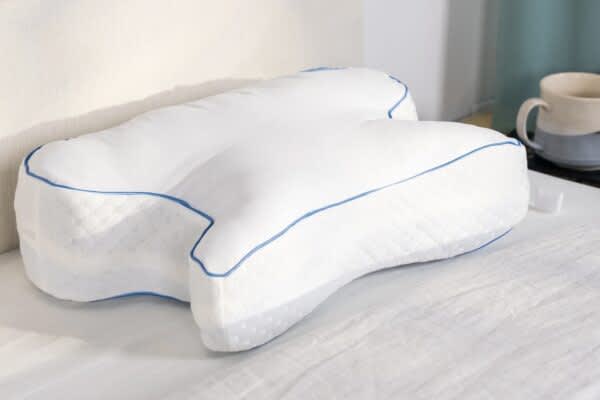
The CPAPmax CPAP Pillow 2.0 from Contour is thoughtfully designed to ensure steady airflow during your therapy and keep you comfortable throughout the night.
Highlights
Highlights
- Contoured shape with side cutouts to accommodate CPAP masks
- Customizable design allows you to adjust the profile
- Tether secures connective tubing to prevent rainout and air leaks
Ideal For
- Too thick for most stomach sleepers
- Foam may produce an off-gassing odor for the first few nights after the pillow is unboxed
Full Details
Best for Side Sleepers
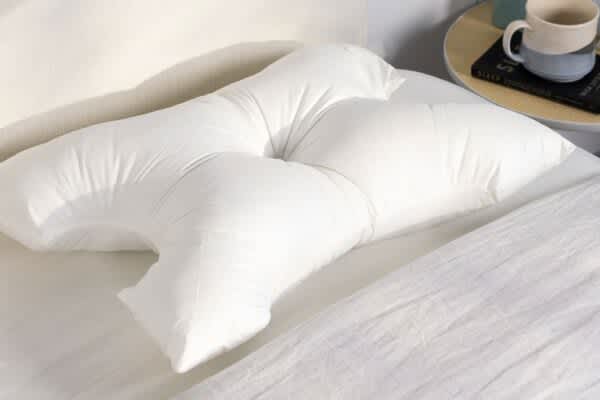
Many people who use CPAP therapy sleep on their sides to ensure steady, uninterrupted airflow — but unfortunately, many pillows are less than ideal for this position.
Highlights
Highlights
- Side cutouts help you sleep comfortably while wearing a CPAP mask
- Contoured shape provides excellent neck support
- Down alternative fill is plush, breathable, and hypoallergenic
Ideal For
- Stomach sleepers may feel neck strain
- Frequent fluffing is required
Full Details
Best for Back Sleepers
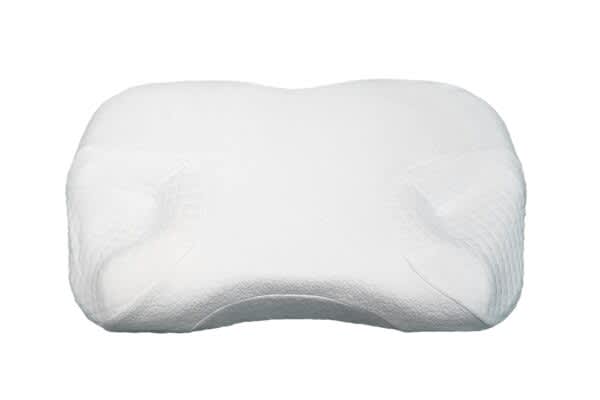
A high-quality pillow doesn’t need to break the bank. Take the Hero CPAP Pillow from cpaphero, which contains solid memory foam that adapts to your head and neck for close, even support. The bottom of the pillow is recessed to ensure these areas are aligned with the rest of your spine, while cutsouts on each side free up space for your face mask and connective tube to maintain a tight seal and prevent air leaks.
Highlights
Highlights
- Contoured shape accommodates your face mask and connective hose
- Recessed bottom supports the neck and cradles the head
- Solid memory foam core is plush and adaptive
Ideal For
- Pillow is on the heavy side and may be difficult to adjust at night
- Strong initial off-gassing odor may occur
Full Details
Best Wedge Pillow
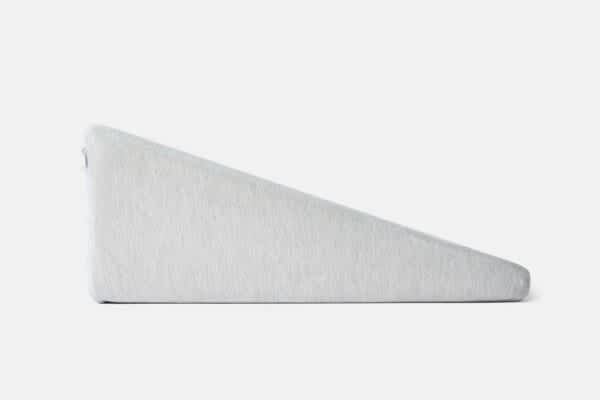
The Helix Wedge Pillow was an obvious pick due to its multi-functional design. A gradual slope elevates the upper body and may alleviate snoring, acid reflux, and post-nasal drip. The 10-inch incline may also reduce neck pain in some people. The sturdy wedge shape doubles as a support pillow when sitting up in bed.
Highlights
Highlights
- Sloped design that props up the upper body
- Machine-washable cover
- Free ground shipping to all 50 states
Ideal For
- May be too firm for some sleepers with neck pain
- Foam produces an off-gassing odor that can linger for several nights
Full Details
Best for Travel
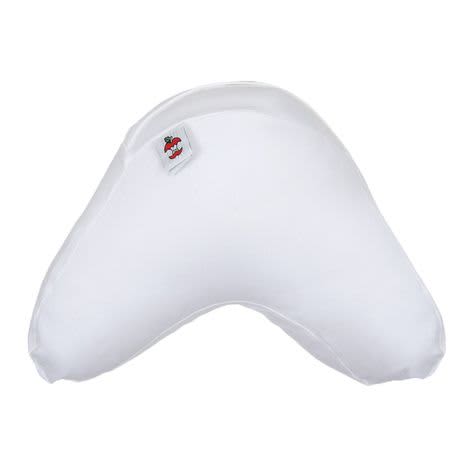
The Core Products Mini CPAP Pillow is smaller and fluffier than the typical CPAP pillow. Its down alternative fill is soft and moldable, yet it still retains its shape well. The pillow is a great alternative for people who find memory foam pillows too firm or heat-retentive.
Highlights
Highlights
- Fluffy yet supportive down alternative fill
- Compact, travel-friendly design
- Breathable cotton cover
Ideal For
- Not ideal for in-home use
- Frequent fluffing needed to maintain a full shape
Full Details
How We Test Pillows
CPAP pillows are an excellent tool for CPAP users looking for enhanced comfort and machine efficiency. To test CPAP pillows, we use a combination of in-person trials and analysis of verified reviews. In our sleep lab, we personally examine loft, firmness, shape, moldability, and durability among other factors.
CPAP machine compatibility is one of the most important factors to consider. To determine whether a pillow will work well with a machine, we consider design features and shape, both of which affect mask and tubing integration. Side, back, and stomach sleepers with a range of body weights try every pillow model and score its support and comfort.
What Is a CPAP Pillow?
A CPAP pillow is a sleeping pillow designed in a way that may make using CPAP therapy more comfortable and secure. These pillows have special features to accommodate CPAP gear and reduce pressure points on the face and head. A well-constructed CPAP pillow may help prevent air leaks by stabilizing a user’s CPAP mask and hose.
Like standard pillows, CPAP pillows come in a huge range of shapes and fill options. Choose one that’s supportive enough for your body weight and sleeping position so that you can get strong spinal support.
How to Sleep With a CPAP Pillow
CPAP users should focus on a pillow’s loft and firmness when choosing a suitable model. Both of these features are key to promoting spinal alignment and making space for CPAP gear. The best height and firmness for you mostly depends on your sleep position, but your upper body size and preferences should also be considered.
| Side sleeping | Many CPAP pillows are designed for side sleeping. Pillows with side cut-outs allow space for your CPAP mask and hose. A moderately thick pillow that’s medium to firm promotes spinal alignment by not allowing your head to sink excessively. One that compresses too much will create pressure points as the mask digs into your face. A bulky pillow without cut-outs can cause air leaks by displacing your mask and hose. |
| Back sleeping | For back sleepers, pillows with a recessed center contour around the neck and reduce shoulder strain. A thinner pillow that is medium to medium firm helps keep your head from elevating too much. Back sleepers should avoid compact designs that might not provide enough shoulder support. Cut-outs aren’t as important since there’s less mask and hose interference when sleeping on your back. |
| Stomach sleeping | Stomach sleeping tends to interfere with CPAP equipment more than any other position. A minimal pillow design that adapts to your headgear is best. Stomach sleepers should look for adjustable pillows made from shredded memory foam or down alternative. These materials are more malleable and help keep masks from digging into your face. |
| Combination sleeping | Since combination sleepers switch positions, they need a versatile pillow with an adjustable loft. A moldable fill or optional inserts lets you adapt the pillow’s height and support to your needs. There are also dual-sided models to accommodate different positions. Most combination sleepers prefer a sizable pillow since it offers more surface area when adjusting positions. |
What Is the Best Sleeping Position for CPAP Therapy?
Sleep position is shown to impact the severity of obstructive sleep apnea (OSA). Studies show that the upper airways are less obstructed when sleeping on your side, especially if the upper body is elevated.
Sleeping on your back is usually the least recommended position, since the throat’s soft tissues are more likely to block the airways in this position. Compared to back sleeping, people with OSA and central sleep apnea (CSA) have fewer breathing lapses when sleeping on their sides.
What Is the Best CPAP Pillow for Side Sleepers?
Side sleepers need a pillow with curves or indents on both sides to make space for a mask and hose. These designs help stabilize masks while preventing them from pushing into your face. Many models also have a recessed area to contour to the neck and shoulders.
How to Pick the Right CPAP Pillow for You
Your mask style and sleep position are top factors when choosing a CPAP pillow. Shoppers should consider how a pillow’s loft and firmness might accommodate their sleep style and CPAP equipment. Hot sleepers will want to note a pillow’s materials and temperature control, while budget-shoppers may need to prioritize value.
As with most purchases, always factor in your preferences and needs when choosing a CPAP pillow model.
Sleep Position
Each sleep position has unique support and comfort needs during CPAP therapy. Side sleepers benefit from a pillow with side cut-outs that provide enough room for a mask. Stomach sleepers should look for a pillow with a recessed center to minimize facial pressure. Wedge or cervical pillows help promote spinal alignment for back sleepers.
Loft
Loft, or a pillow’s height, is crucial to promoting neck support. A suitable thickness is also needed to reduce pressure points from masks. Side sleepers require a thicker pillow to keep the head, shoulders, and spine even.
Pillows with recessed centers give stomach sleepers more space for their masks. A low to medium loft prevents back sleeper’s heads from elevating too much.
Your CPAP Mask
Some mask styles are bulky and require more clearance from a pillow. Full-face masks are the largest, so generous pillow cut-outs may be preferred to minimize interference. Shallow grooves are usually enough to accommodate smaller nasal pillows and nasal masks. It’s important to find a pillow that works around your mask in order to prevent air leaks.
Before you buy a CPAP pillow, check to see if it will work with the type of mask and tubing you already use. Certain styles may get in the way of your tubing and cause it to tangle or disconnect.
Price
CPAP pillows are often more expensive than your typical pillow since they have special design features and sturdier materials. Shoppers can expect to pay between $50 and $150 for a quality CPAP pillow. Most insurance providers don’t cover the cost of CPAP pillows since they are considered non-essential accessories.
Support and Feel
A pillow’s support and feel is related to its firmness and height. Some pillows allow the head to sink in more, while firm pillows may hardly compress.
Sleep position and comfort preferences determine the support you need from a pillow. Side sleepers tend to require thicker and firmer pillows than back and stomach sleepers do.
Temperature Neutrality
Some people tend to sleep hot, and CPAP gear can magnify heat retention. Hot sleepers should look for materials like down alternative, gel infusions, and perforated foams. Covers made from breathable materials like cotton can help wick away heat and moisture.
Prescription, Insurance, and Purchase Information for CPAP Pillows
Unlike CPAP machines, CPAP pillows are considered non-essential equipment and do not require a prescription. Shoppers can purchase CPAP pillows from bedding retailers and medical equipment suppliers.
CPAP pillows are classified as elective accessories, so Medicare and insurance companies usually don’t cover their cost. However, some providers might cover a percentage of certain CPAP accessories, so check with yours before making a purchase.
If your provider does provide partial coverage, you’ll probably have to purchase the pillow upfront, then submit a claim for reimbursement.
CPAP pillows are more widely available than other CPAP accessories since they don’t require a prescription. Shoppers can purchase CPAP pillows from CPAP specialty stores, medical equipment suppliers, and more general sleep stores.
New CPAP users may prefer purchasing from a brick-and-mortar retailer in order to get a feel for the pillow in person. An in-person store also allows the option of bringing in a CPAP mask to gauge compatibility. Online retailers, however, typically offer a wider selection of models. They tend to have lower prices too, since they have fewer overhead costs.
